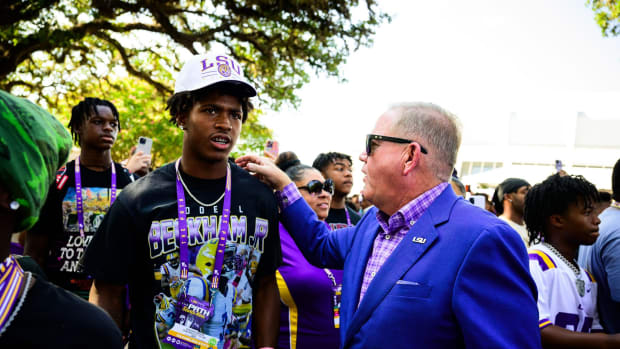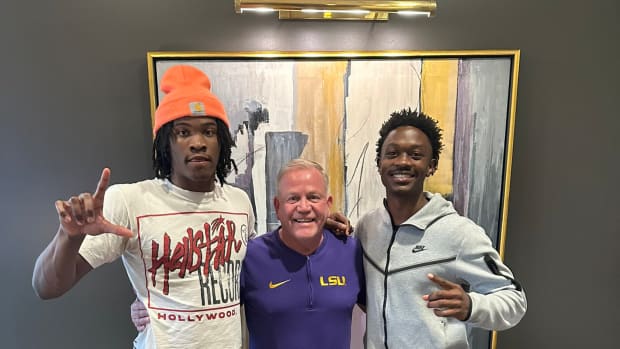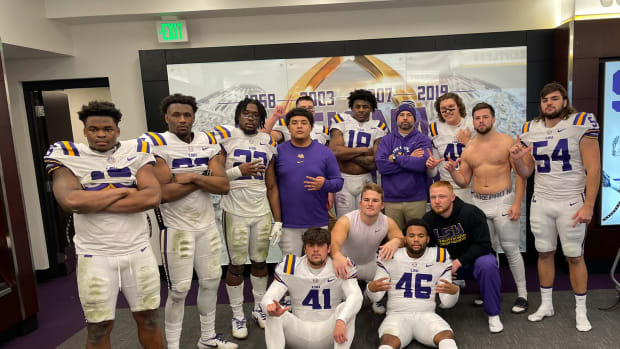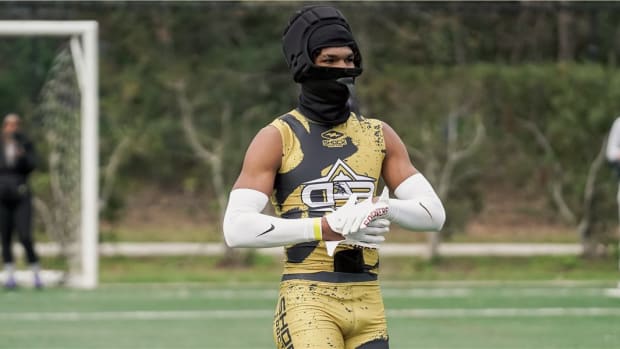What is LSU Football Getting in Offensive Tackle Emery Jones?
Emery Jones pledged to the Tigers, and the Baton Rouge prospect could help the Tigers at multiple positions once he arrives on campus at LSU.
To win in the SEC, it starts up front on both sides of the football. With LSU’s latest commitment, Emery Jones, he presents a unique opportunity for LSU to not only bring onboard a talented offensive lineman, but one that could occupy multiple positions during his time at LSU.
With the Tigers implementing a big-time passing attack in 2019 and continuing that trend last year, players like Jones will be needed in each LSU recruiting class. Yes, the Tigers still need to pound the football and the girth of a player like Jones will come in handy. It’s his quick feet and ability to move with balance and power, however, that make him a really unique talent.
Emery Jones
Vitals: 6’4”, 340-pounds
Position: Offensive Tackle or Offensive Guard
High School: Baton Rouge (La.) Catholic
Class: 2022
Recruitment: Took official visits to Arkansas (June 4), Tennessee (June 18), and Florida State (June 25). Did not officially visit LSU to date, but committed to the Tigers on July 30. Jones was one of Dixie’s most heavily recruited offensive linemen, earning offers from LSU, Ole Miss, Texas A&M, Alabama, Auburn, Tennessee, and Florida among others.
Frame: Very broad across the chest and well distributed weight from his shoulders to his waist. Jones provides the length to play offensive tackle to fend off long and rangy edge rushers common to the SEC. His legs are strong, but there’s ample opportunity to further define his lower body strength. That will also aid Jones with staying flexible, which is arguably his best natural trait. Even in a three-point stance, Jones’ feet lay flat on the ground. That’s fantastic flexibility, especially for a player weighing over 300 pounds.
Playing Style
Jones can be nasty. He likes to roll over smaller and quite frankly overmatched defenders. He’s not giving anyone a break, that’s for sure. Jones will also hustle in space and seek out a defensive player to block. That’s always a welcomed trait.
He can be aggressive or play the waiting game with pass protection, but either way his long and athletic body overpowered the vast majority of players attempting to run by him. During pass protection, Jones showed a good kick step with solid knee bend. He looked comfortable with this and it could allow him to stay at offensive tackle for LSU.
Power
Jones moves people against their will as one would expect a 340 pound player to do. What’s impressive is Jones would do that despite sometimes displaying a really high blocking base, especially once he engaged a defender. He needs to stay lower to drive more talented players, i.e. play through his hips and not his shoulders and chest. There is a flip side to that equation.
Once Jones consistently lowers his pad level, his natural power will be all the more impactful as he attempts to beat a defender one-on-one. His upside as a run blocker in this regard is incredible, and it leads into something he already does fairly well, zone blocking.
Zone Blocking
Jones’ first step is quick; he will take an immediate outside zone step to gain the edge against a defensive end that’s lined up to the outside of Jones’ uncovered shoulder (no offensive lineman to that side). This is a good sign that he’s already progressed with the coaching provided to him by the Baton Rouge Catholic coaching staff because it’s not as easy to make this maneuver as one might believe. Catholic is a really good program, and Jones took advantage of the tutelage through his junior season to consistently make those types of zone blocks.
Advanced Playing Technique
Jones consistently fired off the line of scrimmage and climbed to the second level after an initial double team with an offensive line teammate. He did so without hunting linebackers with too much aggression. He utilized short, choppy steps approaching second-level opponents and would wall off a linebacker or safety if a direct hit did not present itself. If nothing else, those types of second-level blocks provide evidence that Jones is an intelligent player that knows how to calculate his strategy well in advance of reaching a defender.
Technical Area to Improve
When pass protecting, Jones would sometimes be late to “punch” as the pass rusher came closer to him. A punch simply means an offensive lineman’s ability to shoot his hands towards a defender and stun his current path. Once slowed down, it’s much easier to dictate to the opposing player.
Jones sometimes failed to punch soon enough, and this presents a few issues. When giving a talented player from say Texas A&M or Alabama that advantage, that’s often going to be a quarterback hurry or sack. They will have the skill and technique to destroy poor timing with a punch.
Second, Jones needs to set the tone with a punch because it can be a mind game as much as a physical game with pass rushers. Once they fear an offensive tackle’s punch, there’s a better chance they will not perform at a high level. Finally, Jones simply needs to use his size, athleticism and length to help keep a clean pocket. Just cannot have a quarterback taking free shots from any defender, even if it becomes just one or two hits during a game.
Future Options for the Tigers
Attempting to project Jones at only one position is nearly impossible. He’s a valuable asset as he presents the type of athleticism, length, and savvy to be an offensive tackle. His size (remember, 340 pounds), intelligence, and ability to consistently come off double team blocks to help the running game also make Jones intriguing as an interior offensive line prospect. Overall, it’s likely best to assume that Jones will see time at tackle and at guard for the Tigers.




